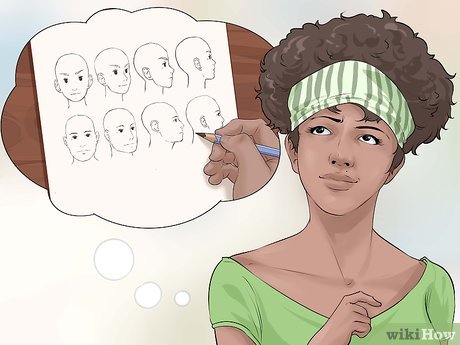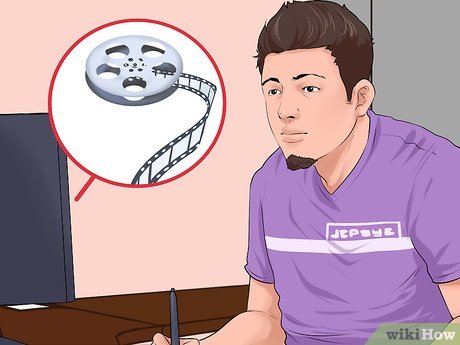How to Become a Computer Animator
Part 1 of 3:
Getting the Necessary Education and Experience
-
 Focus on drawing, creative writing, and science classes in high school. As a computer animator, you will need to have strong visual art skills like drawing, sculpture, and design. Focus on these skills in your art classes in high school and try to immerse yourself in art history through books, films, and visits to your local museum. You should also try to take classes in computer-aided drafting (CAD) if they are offered at your high school or research CAD online.[2]
Focus on drawing, creative writing, and science classes in high school. As a computer animator, you will need to have strong visual art skills like drawing, sculpture, and design. Focus on these skills in your art classes in high school and try to immerse yourself in art history through books, films, and visits to your local museum. You should also try to take classes in computer-aided drafting (CAD) if they are offered at your high school or research CAD online.[2]- It will also be helpful to become well versed in creative writing and storytelling, as a big element of the role of a computer animator is bringing stories to life. Take a drama or class in theater as well as a writing class to help develop your creative skills.
- A good understanding of scientific fields like physics, and a strong grasp of mathematics will also help you become a better animator.
-
 Earn a bachelor's degree in computer science animation. Most employers require applicants to have a Bachelor of Arts in Computer Animation from an accredited university or college. You will learn the necessary skills in digital art, drawing, and storyboarding, as well as the computer software needed to be a qualified computer animator.[3]
Earn a bachelor's degree in computer science animation. Most employers require applicants to have a Bachelor of Arts in Computer Animation from an accredited university or college. You will learn the necessary skills in digital art, drawing, and storyboarding, as well as the computer software needed to be a qualified computer animator.[3]- You may decide to specialize in a specific area of computer animation, such as game design. You would then pursue your Bachelor of Science in Game Design and Development. This degree program will help you attain the skills required to design video games and training simulations.
- Keep in mind some computer animators are self-taught and learn their skills from mentors working in the field. However, even self-taught animators will take animation or art-related classes to further develop their skills and make them more employable.
-
 Learn software packages that are commonly used in computer animation. Many bachelor level programs in computer animation will allow you to develop your software skills and give you a basic level of understanding of several different computer programs. There are several commonly used software packages in the computer animation industry that may be useful for you to learn, including:[4]
Learn software packages that are commonly used in computer animation. Many bachelor level programs in computer animation will allow you to develop your software skills and give you a basic level of understanding of several different computer programs. There are several commonly used software packages in the computer animation industry that may be useful for you to learn, including:[4]- Flash
- Maya
- 3D Studio Max
- Lightwave 3D
- Aftereffects
- Photoshop
- Illustrator
- CorelDraw
- You may also need to learn software packages on the job that are specific to your employer or to your role. You should be open to learning new software and able to adapt to the changing software demands of computer animation.
-
 Do an internship at an animation studio. Some bachelor programs in computer animation have an internship component where you can gain practical experience at an animation studio. Many internships are available during your junior year of school and have a basic level of technical knowledge.[5]
Do an internship at an animation studio. Some bachelor programs in computer animation have an internship component where you can gain practical experience at an animation studio. Many internships are available during your junior year of school and have a basic level of technical knowledge.[5]- You can also apply for internships outside of your program through organizations like The Academy of Television Arts and Sciences Foundation.
Part 2 of 3:
Looking for a Position
-
 Create a demo reel. The biggest selling point for any computer animator is their demo reel, which is a video based portfolio that showcases their best work. In fact, 51% of industry experts note that your demo reel is the most important element of landing a job or a client.[6] Your demo reel should be dynamic, engaging, and well put together. Try to upload your demo reel to the web so it is easy to access for potential employers.[7]
Create a demo reel. The biggest selling point for any computer animator is their demo reel, which is a video based portfolio that showcases their best work. In fact, 51% of industry experts note that your demo reel is the most important element of landing a job or a client.[6] Your demo reel should be dynamic, engaging, and well put together. Try to upload your demo reel to the web so it is easy to access for potential employers.[7]- Your demo reel should be well edited to show your drawing, painting, or sculpting skills if you are strong in these areas. Focus on video that shows your use of an extendable rig, a walk cycle turntable, and any collaborative work you have done with other animators or other creatives. Your demo reel should also show your unique animation style and be engaging for the viewer from beginning to end.[8]
- You should also create a professional website to post examples of your current projects and to better showcase your demo reel. When you upload your demo reel to your website, make sure you copyright it and are able to retain control over it once it is online. Include your resume, your contact information, and a brief bio. You should also include concept sketches, storyboards, sketches, or drawings that you are proud of to give potential employers a better sense of your visual style.
-
 Join a professional computer animators association. Membership to an industry association like the Computer Graphics Society (CG Society) or the ASIFA Hollywood Association can give you a platform to share your work with other animators and to attend workshops to further develop your animation skills.[9]
Join a professional computer animators association. Membership to an industry association like the Computer Graphics Society (CG Society) or the ASIFA Hollywood Association can give you a platform to share your work with other animators and to attend workshops to further develop your animation skills.[9]- Membership to these associations are not free but they do come with many perks and many of these associations have job listings that are only available to members.
-
 Look for a full time position through your internship position. If you have managed to land a great internship at an animation studio, you should try to network with as many peers, supervisors, and creatives as the studio as possible. Establishing good working relationships during your internship could then translate to a full time position once your graduate from your undergraduate program.
Look for a full time position through your internship position. If you have managed to land a great internship at an animation studio, you should try to network with as many peers, supervisors, and creatives as the studio as possible. Establishing good working relationships during your internship could then translate to a full time position once your graduate from your undergraduate program. -
 Apply to open positions at animation studios. Before you apply for positions at animation studios, you should consider if you would like to focus on an area of specialization or a specific industry. Are you more interested in animation for the motion picture and video industry or the advertising and public relations industry? Maybe you would prefer to work on character animation and visual effects at a large studio or as a teacher or administrator in a computer animation program. Narrowing down your interests can allow you to apply for open positions that speak to your level of interest and you can then demonstrate your passion for a certain industry or position in your job interviews.[10]
Apply to open positions at animation studios. Before you apply for positions at animation studios, you should consider if you would like to focus on an area of specialization or a specific industry. Are you more interested in animation for the motion picture and video industry or the advertising and public relations industry? Maybe you would prefer to work on character animation and visual effects at a large studio or as a teacher or administrator in a computer animation program. Narrowing down your interests can allow you to apply for open positions that speak to your level of interest and you can then demonstrate your passion for a certain industry or position in your job interviews.[10]- You should tailor your resume to reflect the skills required for the positions you are applying for. This could mean highlighting your character animation experience and visual effects experience for a character animation position at an animation studio, as well as your strong communication skills and your strong grasp of software packages. Or you may emphasize your story boarding experience and your passion for storytelling for a position in motion picture animation.
- If you are interested in becoming a freelance computer animator or starting your own computer animation studio, you should spend several years working under a mentor who can help you to develop your artistic skills and your business knowledge. You should put in at least five years of working for others and learning from mentors in the industry before you decide to strike out on your own as a freelancer or a studio owner.[11]
Part 3 of 3:
Understanding the Role
-
 Recognize the difference between a cartoonist and a computer animator. A computer animator is different than a cartoonist as an animator works with 3D software to build animated objects, people, and images. Though you will need to have excellent drawing skills, you will be using software and computers to create animations, rather than pen and paper.[12]
Recognize the difference between a cartoonist and a computer animator. A computer animator is different than a cartoonist as an animator works with 3D software to build animated objects, people, and images. Though you will need to have excellent drawing skills, you will be using software and computers to create animations, rather than pen and paper.[12]- As a computer animator, you will still be able to tell stories and be artistic but you will also need to be skilled in software and computers. You are expected to be a highly skilled visual artist who can use technology with confidence and expertise.
-
 Keep in mind the pay scale. The average yearly salary for multimedia animators was $64,470 in 2013.[13] However, your pay can fluctuate based on the industry you are employed in. You may also be paid more or less if you work per hour rather than on a salary basis. Computer animators who work for themselves as freelancers may arrange hourly pay or pay per project, depending on their clients.
Keep in mind the pay scale. The average yearly salary for multimedia animators was $64,470 in 2013.[13] However, your pay can fluctuate based on the industry you are employed in. You may also be paid more or less if you work per hour rather than on a salary basis. Computer animators who work for themselves as freelancers may arrange hourly pay or pay per project, depending on their clients.- The highest paying industries for computer animators are the motion picture and video industries ($84,610) and the software publishers industry ($72,230). You may also be employed in the computer systems design industry, with an annual mean wage of $67,740, the advertising and public relations industry ($65,760) and the specialized design services industry ($63,350).[14]
-
 Be aware of the work environment. The work environment for a computer animator will shift depending on what industry you work in and if you work for a large animation studio or on your own as a self-employed animator.
Be aware of the work environment. The work environment for a computer animator will shift depending on what industry you work in and if you work for a large animation studio or on your own as a self-employed animator.- If you work at a large animation studio, you will likely work in an office environment with other animators and designers. You may work in a team on specific projects or have a hand in several ongoing projects at a time. If you work for yourself as a freelance computer animator, you will likely work from a home office.
4 ★ | 1 Vote
You should read it
- 7 best computer animation software
- Instructions to turn off Focus Ring Animation on Mac
- Animation in JavaScript
- 6 months for 8 skills and life you will change!
- Should I tell my boss: 'I'm not happy with the job' or are I quiet and leave?
- Using 1 hour after work will determine your success
- 4 signs that you are talking too much at work
- How to create GIF images on GIF Movie Gear
May be interested
- Learn to use lesson computer 15 - Keep the computer clean
 in addition to being able to cause cosmetic problems as well as health for us, dirt can potentially damage or even destroy computer components.
in addition to being able to cause cosmetic problems as well as health for us, dirt can potentially damage or even destroy computer components. - Learn to use lesson 9 computer - Set up a computer
 you just bought a new computer, the first thing you have to do is set up your computer to suit your purpose.
you just bought a new computer, the first thing you have to do is set up your computer to suit your purpose. - Learn to use lesson computer 16 - Protect your computer
 what can you do to protect your computer system as much as your important data from potential external threats?
what can you do to protect your computer system as much as your important data from potential external threats? - Self-assembling computers, build desktop computers (P1): Choose hardware
 self-assembling computers can be quite difficult for inexperienced personal users, but not impossible. you want to build your own computer to play games, save money, be curious or simply want to create a computer that suits you. whatever the purpose of building your own computer, this tutorial series will definitely be useful to you.
self-assembling computers can be quite difficult for inexperienced personal users, but not impossible. you want to build your own computer to play games, save money, be curious or simply want to create a computer that suits you. whatever the purpose of building your own computer, this tutorial series will definitely be useful to you. - How to set up a USB-only computer, increase safety
 it will be dangerous if strange usb devices contain a virus or malicious code that is arbitrarily connected to the computer when you are not sitting in front of the computer. do not worry, we will guide you how to set up the computer to receive only the secured usb.
it will be dangerous if strange usb devices contain a virus or malicious code that is arbitrarily connected to the computer when you are not sitting in front of the computer. do not worry, we will guide you how to set up the computer to receive only the secured usb. - Test on computer network with answer P9
 computer network is a group of computer devices connected to each other through twisted cables, electromagnetic waves ... to share data for each other. today day computer networks are widely used. in the article below, network administrator will help you find out more about this topic through multiple choice questions.
computer network is a group of computer devices connected to each other through twisted cables, electromagnetic waves ... to share data for each other. today day computer networks are widely used. in the article below, network administrator will help you find out more about this topic through multiple choice questions. - Things to know about a computer engineer
 in the era of information technology as today, the demand for recruitment for positions in technology sector is increasing, and jobs in this field are becoming the dream of very many young people.
in the era of information technology as today, the demand for recruitment for positions in technology sector is increasing, and jobs in this field are becoming the dream of very many young people. - 8 Ways to Clean Up Computer Junk to Speed Up Computer 2024
 when using a computer for a very long time, your computer will become slow and sluggish. to make your computer run faster and smoother, you need to clean up the junk on your computer.
when using a computer for a very long time, your computer will become slow and sluggish. to make your computer run faster and smoother, you need to clean up the junk on your computer. - 2 How to change the name displayed on the computer
 during use, you may want to change your computer's display name to a new name, possibly due to a transfer of the rights to use the computer or you do not like the old name installed by the installer. but the problem is that you do not know how to change? therefore, today, tipsmake.com will guide you 2 ways to rename your computer very quickly and simply.
during use, you may want to change your computer's display name to a new name, possibly due to a transfer of the rights to use the computer or you do not like the old name installed by the installer. but the problem is that you do not know how to change? therefore, today, tipsmake.com will guide you 2 ways to rename your computer very quickly and simply. - Speed up your computer - 12 steps to have a computer that always looks like new
 guide to speeding up the most effective computer. share 12 tips to help your computer work as stable as new, without jerks, lag when using. sharing computer knowledge is extremely effective
guide to speeding up the most effective computer. share 12 tips to help your computer work as stable as new, without jerks, lag when using. sharing computer knowledge is extremely effective

















 How to Become an Information Technology Consultant
How to Become an Information Technology Consultant How to Become a System Analyst
How to Become a System Analyst How to Sell IT Services
How to Sell IT Services How to Start a Cyber Security Career
How to Start a Cyber Security Career How to Become an IT Consultant
How to Become an IT Consultant How to Get a Degree in Information Technology
How to Get a Degree in Information Technology